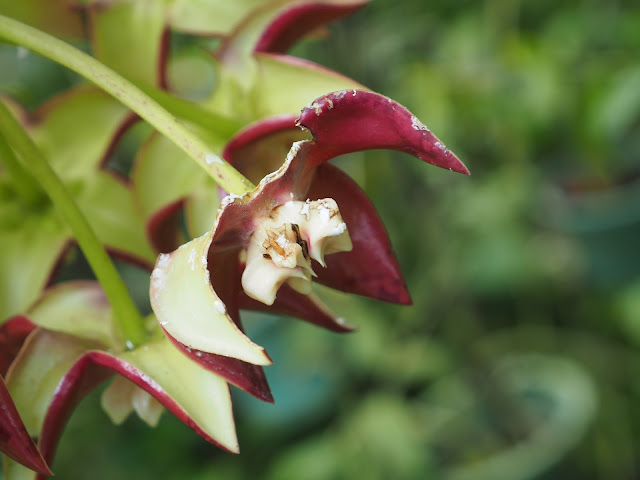Our garden here in the hot tropics is made lovelier and more alive by the rains. Rains allow nice growths of plants, both for food and ornamentals. This is somehow vague as even the ornamentals are food of other entities in the food chain. I don't normally plant food for humans, except for the fruit trees in our property, but i always plant for flowers with the intention of attracting the butterflies.
Since July the butterflies and other insects are happy partaking with the food available in our property. The larvae are also happy for the new growths. Nobody in our vicinity applies any pesticide, so pests and diseases are just left there at the mercy of their natural predators.
The male common mormon is now here sipping from the red Pentas lanceolata. But it wanders on all the flowers in front of our house.
This is a white petunia which just voluntary emerged in one of the pots. We have one plant 2 years ago, maybe one seed didn't germinate for 2 years and succeed this year. I didn't know that petunia seed can last that long in the soil, passing through our harsh dry seasons without totally drying. Unfortunately, it is not attractive to butterflies.
Impatiens balsamina, locally known as kamantigue, was introduced to our garden from some seeds i got from different places. They seed a lot even as annuals, which scattered to the ground and emerge like weeds during the dry season. Last year we have the pink, but it was not able to tolerate the long dry season. Now we only have the purple and white, probably next year the pinks will emerge as new hybrids. The big female Scarlet Mormon sips unabashedly under those leavs, even if the flowers are very near the ground.
The whites are elegant as well. However, i noticed that they are not as attractive to butterflies than the purples. That i cannot understand yet, i only know that yellows are the most attractive for them.
Their flowers are favorites also of butterflies, although the blue banded bees are the most common visitors i see on them.
If the emerging seedlings are not thinned, your grounds will end up like this. I told you they are invasive if allowed. Even the areas outside the garden, under the fruit trees are fully loaded with this cover. The only good thing about them is that they are easily pulled out, a little pressure will get their roots. Unfortunately, we lack time pulling them out.
The only anthurium with us is also flowering continuously on both seasons. However, i haven't seen any insect visiting it, except for a few ants.
Turnera ulmifolia is drought tolerant, and produce lots of seeds too. It is one of the regulars even during our long dry season. It is deeply rooted allowing it to get moisture deeper into the ground. The consequence for us is the difficulty of pulling them off when we don't want the plant anymore, or if they already gets too old and scraggly. Some butterflies and the stingless bees love them too.
The bougainvillea flowers all year round, but growth is more profuse during the rainy season. Some butterflies alight on its flowers too. Can you see the bluish butterfly at the middle, a wanderer Pareronia boebera boebera. It is the only butterfly during last weekend which frequently visits the bougainvillea. Maybe next time i will record the nectar plants preference for specific butterfly species.
The rainy season induce them to produce more suckers, and they get so invasive. Above shows their density in that area, doesn't look like a part of the garden anymore. At the end of the rainy season, most of them will be cut to lessen their numbers. Can you see the volunteer chili peppers in front? These are the favored chili because of its strong spicy flavor, put in condiments. But we also get the young leaves and tops to put in our stew.
This is another revelation, i just noticed that it has a very long proboscis to suck nectar. I also observed that it can sip even if not alighted on the flower, but staying on air just fluttering its front wings. Hmm i learn a lot from these night shots. The moth is Opthalmis lincea.
Tagetes japitus titus or Common Snow Flat on my Hoya cv Viola. I love them when they alight on my hoyas.
































